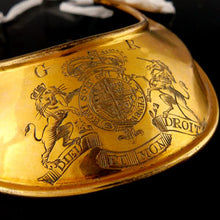A George III 40th Regiment Officer’s Gorget, 1768-98
Adding product to your cart
9.5cm (3.7in) x 2.2cm (0.8in) x 8cm (3.1in)
Formed from a single piece of gilt brass, its rim rolled around a length of wire, engraved with the Royal arms of 1714-1801 and G R for Georgius Rex above, each arm engraved with regimental badge 40RT within a wreath suspended from knotted cords.
The 40th (2nd Somersetshire) Regiment of Foot has a long history associated with North America and Nova Scotia. Originally organised for the defence of Annapolis Royal after its capture from the French in 1710, it was in Boston, Massachusetts in June 1775 at the outbreak of the American War of Independence (1775-83). It fought in several engagements, including Long Island (1776), Princeton (1777) and Germantown (1777), before returning to the West Indies, where it helped capture St Lucia (1778). The 40th moved to Britain for the first time in 1783, and given its county association with Somerset. In the French Revolutionary Wars, its battalion companies fought in Flanders and Brittany in 1794-95, while its flank companies deployed to the West Indies to takepart in the capture of Martinique (1794). The regiment reunited in the West Indies in 1795, serving on Santo Domingo and Jamaica, before returning to Britain in 1798.
Gorgets, as worn by infantry officers in the British and Continental armies, were a last vestige of armour and a reminder of the knightly rank of their predecessors on the battlefield. A British Army Clothing Warrant of 1768 specified that officers’ gorgets were to match the colour of the lace worn on the officers’ coats: thus, in the 40th Regiment in which the officers wore gold lace on their coats, the gorgets were required to be gilded. In addition, in 1768, British line infantry regiments were allowed to place regimental devices or numbers on their officers’ gorgets. These regulations remained in force until 1796 when a Universal Pattern Gorget was introduced for line infantry regiments. In the British army gorgets of all variants were abolished in 1830.






